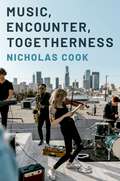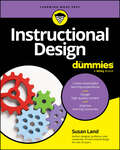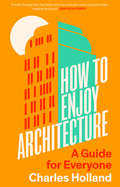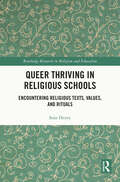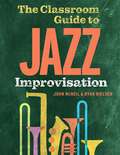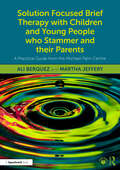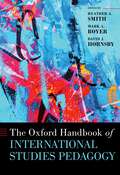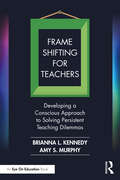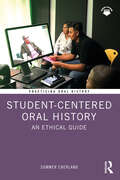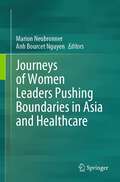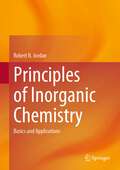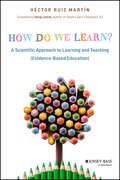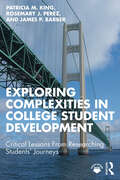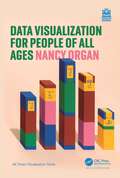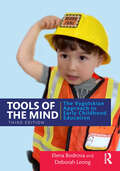- Table View
- List View
Music, Encounter, Togetherness
by Nicholas CookIn today's technological and globalised world, music remains a basic dimension of society. Music, Encounter, Togetherness outlines a relational approach to music that creates space for both human agency and social relationship. Throughout the book, author Nicholas Cook puts Euro-American musical traditions into dialogue with other world music cultures, complementing theory-driven approaches with comprehensive case studies ranging from late eighteenth-century India to contemporary China, and from Debussy's encounter with Javanese music and dance to cross-cultural musicking in Australia and in cyberspace. Through these examples, Cook examines how music affords interpersonal relationship and social togetherness, and what happens when musicians from different cultures interact. Central to the book is the idea of encounter, which highlights the dynamic and processual nature of musicking, as much in therapy or at home as in the jazz club or concert hall. Western musicologists have traditionally thought of music as primarily a repertory of objects; Cook illustrates how thinking of it in processual terms--through an expanded idea of performance--can make as much sense of Western art music as of other traditions. In basing an understanding of music on acts rather than objects and focussing on people and their relationships rather than on the impersonal forces of evolutionary or stylistic histories, the book opens up ways of thinking that counter some of the dehumanising aspects of musical thinking and practice in global modernity.
Instructional Design For Dummies
by Susan M. LandThe streamlined, simplified, beginner-friendly introduction to instructional design Instructional Design For Dummies will teach you how to design and build learning content to create effective, engaging learning experiences that lead to improved learning outcomes and skill development. This book breaks down the instructional design process into bite-sized pieces, so you can learn techniques and best practices without getting bogged down in theory. Learn about various instructional design models and frameworks, then discover the different options for designing learning experiences. Take into account learning foundations, goals, and contexts, then create stellar lessons for in-person or virtual delivery. This Dummies guide is your starting place for creating impactful courses, without the technical jargon. Learn the basics of instructional design so you can create meaningful learning experiences Discover techniques that will help you design high-quality content for any context Improve learning outcomes and deliver training content with greater efficiency Skip the complex theories and technical jargon and focus on the info you need to knowThis book is perfect for anyone who needs to develop a course, design a curriculum or training program, or provide educational content without being formally trained in instructional design. It’s also a great supplement to college-level instructional design courses. Whatever you’re teaching, Instructional Design For Dummies will help you teach it better.
How to Enjoy Architecture: A Guide for Everyone
by Charles HollandCharles Holland challenges us to look beyond the day-to-day familiarity of buildings to rediscover the pleasure of experiencing architecture Architecture is bound up with our daily lives but, for most of us, it is experienced as a blur of habit. Our reactions towards the buildings that surround us are often culturally generated, and we experience them in ways that are immediate but often mundane. How to Enjoy Architecture: A Guide for Everyone encourages us to move beyond this and, instead, really look at buildings. Renowned architect Charles Holland talks about the buildings and architects that excite and inspire him, and the ideas and principles through which we can engage with architecture. By breaking buildings down into categories such as materials, structure, space, and use, Holland guides us through drastically different styles and building types—from the satisfying symmetry of a Queen Anne house to the thrill of a high-tech tower, or the social ideals that lie behind a housing estate. In doing so, he demonstrates how looking at, experiencing, and using architecture can bring joy in itself. "A book that will enrich any encounter with a building, it made me want to look harder and be more curious. We are led playfully through the fundamentals of architecture so that we might enjoy the details and the poetry of buildings all the more. A walk through the city feels more fun and also more profound after reading this book." Grayson Perry, artist "We so often encounter architecture when it goes wrong, or offends us with its looks. Holland, though, is the perfect, clear-headed tour guide to help us appreciate it with newly sharpened senses and fall in love again – even those buildings we think we hate." Tom Dyckhoff, academic and broadcaster "An enlightening and urbane exploration of architecture that resonates beyond conventional chronological histories" Catherine Slessor, architecture writer and critic  
Queer Thriving in Religious Schools: Encountering Religious Texts, Values, and Rituals (Routledge Research in Religion and Education)
by Seán HenryThis book offers an account of religious schooling committed to ‘queer-thriving’ and envisions how queer staff and students can live their lives without being ‘accommodated’ within heteronormative religious traditions.Engaging with queer theological perspectives across the Jewish, Christian, and Muslim traditions, the book begins by situating queer thriving as a viable part of the work of the religious school, and not just as something reserved for progressive education more broadly. Taking three areas that are typically used to justify religious heteronormativity (religious texts, religious values, religious rituals), it engages queer theologies to showcase how an educational approach committed to queer thriving can be enacted in religious schools in ways that are also theologically sensitive. The book then explores how religious school communities can navigate differences around queerness and religion in ways that are supportive of queer staff and students. It takes desire as an everyday reality in classrooms and applies a queer lens to this to challenge heteronormativity and to imagine alternative modes of relationship between staff, students, and communities that enable queer staff and students to thrive.Showcasing possibilities of resistance for the opposition between religious and queer concerns, it will appeal to researchers, postgraduates and academics in the fields of religion and education, whilst also benefitting those working across philosophy of education and educational theory, sex education, sociology of education, social justice education, queer theologies, religious studies, and sociology of religion.
Queer Thriving in Religious Schools: Encountering Religious Texts, Values, and Rituals (Routledge Research in Religion and Education)
by Seán HenryThis book offers an account of religious schooling committed to ‘queer-thriving’ and envisions how queer staff and students can live their lives without being ‘accommodated’ within heteronormative religious traditions.Engaging with queer theological perspectives across the Jewish, Christian, and Muslim traditions, the book begins by situating queer thriving as a viable part of the work of the religious school, and not just as something reserved for progressive education more broadly. Taking three areas that are typically used to justify religious heteronormativity (religious texts, religious values, religious rituals), it engages queer theologies to showcase how an educational approach committed to queer thriving can be enacted in religious schools in ways that are also theologically sensitive. The book then explores how religious school communities can navigate differences around queerness and religion in ways that are supportive of queer staff and students. It takes desire as an everyday reality in classrooms and applies a queer lens to this to challenge heteronormativity and to imagine alternative modes of relationship between staff, students, and communities that enable queer staff and students to thrive.Showcasing possibilities of resistance for the opposition between religious and queer concerns, it will appeal to researchers, postgraduates and academics in the fields of religion and education, whilst also benefitting those working across philosophy of education and educational theory, sex education, sociology of education, social justice education, queer theologies, religious studies, and sociology of religion.
The Classroom Guide to Jazz Improvisation
by John McNeil Ryan NielsenYou don't have to be a jazz expert to give your students a great introduction to improvisation. The Classroom Guide to Jazz Improvisation provides what music educators have sought for decades: an easy, step-by-step guide to teaching jazz improvisation in the music classroom. Offering classroom-tested lesson plans, authors John McNeil and Ryan Nielsen draw on their combined 54 years of teaching experience and extensive work as professional jazz musicians to remove the guesswork and mystique from the teaching process. Each lesson is founded in the authors' realization that the brain responds differently to improvisation than it does rote memory. The resulting lesson plans are flexible, easy to use, and equip students with a quick understanding of the simple choices they can make to create effective jazz lines. Lessons are designed for a range of settings, from ensemble rehearsal to private instruction. Music educators may find relief in the concrete, straightforward materials on rhythm section instruments like bass, drums, piano, and guitar. Beyond the nuts and bolts of improvisation, this book contains carefully curated listening lists, honest discussions about the meaning of the music, and talking points to advocate for jazz programs to administrators and parents. With an inviting and conversational approach, The Classroom Guide to Jazz Improvisation is an essential resource for all music educators, from early career teachers to seasoned instructors.
Solution Focused Brief Therapy with Children and Young People who Stammer and their Parents: A Practical Guide from the Michael Palin Centre
by Ali Berquez Martha JefferyThis book offers speech and language therapists, and other allied health professionals, a practical resource for working in a distinctive way with children and young people, and their parents, to achieve their ‘best hopes’ from therapy. The authors share a wealth of knowledge and experience from the Michael Palin Centre for Stammering about how they use Solution Focused Brief Therapy to enhance their practice. This resource manual: Provides a step-by-step guide to starting solution-focused conversations, having follow-up meetings, drawing attention to what’s working, and ending well. Illustrates work with a broad range of clients who stammer, including clients with additional physical, learning, and emotional needs. Demonstrates the benefits of working systemically with children and young people and their parents or carers. Supports therapists to develop skills in working collaboratively with clients on what they want to achieve from therapy. Gives examples of how to ask helpful questions and have hope-filled conversations. Considers the benefits and challenges of working in a solution-focused way. Describes how to adapt solution-focused conversations according to the client’s age and stage. Presents a range of applications of SFBT including in groups and in clinical supervision. The manual is illustrated by a rich variety of case examples which brings the material to life and enables the reader to apply the principles to their own setting. It is an essential practical resource for therapists hoping to develop their skills in empowering parents and in supporting children and young people towards living their best life.
The Oxford Handbook of International Studies Pedagogy (Oxford Handbooks)
by Heather A. Smith, Mark A. Boyer, and David J. HornsbyThe Oxford Handbook of International Studies Pedagogy brings together world class scholars to describe and analyze a wide array of pedagogical approaches and developments in International Studies. It reflects the extraordinary creativity visible in the ways instructors in International Studies interact, engage, and struggle with the students in their classrooms. The first section of the volume exposes readers to different worldviews, teaching worlds, and methods that enable a more diverse set of considerations when thinking about the international. Chapters in this section demonstrate a set of pedagogical practices that can allow non-western perspectives to emerge and to be valued. This maintains import beyond simply enabling broader literatures, contexts, and experiences to enrich the study of the international-it also is a critical component of adopting a set of humanizing pedagogies where care, inclusion, and compassion are modelled. At the heart of some of the contributions is a recognition that being more thoughtful and engaging of our students in constructing the learning environment is fundamental to enabling a broader set of worldviews and teaching worlds to emerge. The second section of the volume focuses on teaching and learning inside and outside the classroom. The chapters in this section fundamentally talk about strategies, and particular experiences that people have had, and how they relate those experiences either to their own positions or how they have understood them to be effective. While the chapters tend to focus on practice, it is also apparent how contributors embed their work in a set of values around equity, diversity, inclusion, and reconciliation. Ultimately, accepting the way we teach matters, and this volume seeks to empower those teaching international studies to engage their students and prepare them to understand and work within a complicated and challenging international system.
The Classroom Guide to Jazz Improvisation
by John McNeil Ryan NielsenYou don't have to be a jazz expert to give your students a great introduction to improvisation. The Classroom Guide to Jazz Improvisation provides what music educators have sought for decades: an easy, step-by-step guide to teaching jazz improvisation in the music classroom. Offering classroom-tested lesson plans, authors John McNeil and Ryan Nielsen draw on their combined 54 years of teaching experience and extensive work as professional jazz musicians to remove the guesswork and mystique from the teaching process. Each lesson is founded in the authors' realization that the brain responds differently to improvisation than it does rote memory. The resulting lesson plans are flexible, easy to use, and equip students with a quick understanding of the simple choices they can make to create effective jazz lines. Lessons are designed for a range of settings, from ensemble rehearsal to private instruction. Music educators may find relief in the concrete, straightforward materials on rhythm section instruments like bass, drums, piano, and guitar. Beyond the nuts and bolts of improvisation, this book contains carefully curated listening lists, honest discussions about the meaning of the music, and talking points to advocate for jazz programs to administrators and parents. With an inviting and conversational approach, The Classroom Guide to Jazz Improvisation is an essential resource for all music educators, from early career teachers to seasoned instructors.
Solution Focused Brief Therapy with Children and Young People who Stammer and their Parents: A Practical Guide from the Michael Palin Centre
by Ali Berquez Martha JefferyThis book offers speech and language therapists, and other allied health professionals, a practical resource for working in a distinctive way with children and young people, and their parents, to achieve their ‘best hopes’ from therapy. The authors share a wealth of knowledge and experience from the Michael Palin Centre for Stammering about how they use Solution Focused Brief Therapy to enhance their practice. This resource manual: Provides a step-by-step guide to starting solution-focused conversations, having follow-up meetings, drawing attention to what’s working, and ending well. Illustrates work with a broad range of clients who stammer, including clients with additional physical, learning, and emotional needs. Demonstrates the benefits of working systemically with children and young people and their parents or carers. Supports therapists to develop skills in working collaboratively with clients on what they want to achieve from therapy. Gives examples of how to ask helpful questions and have hope-filled conversations. Considers the benefits and challenges of working in a solution-focused way. Describes how to adapt solution-focused conversations according to the client’s age and stage. Presents a range of applications of SFBT including in groups and in clinical supervision. The manual is illustrated by a rich variety of case examples which brings the material to life and enables the reader to apply the principles to their own setting. It is an essential practical resource for therapists hoping to develop their skills in empowering parents and in supporting children and young people towards living their best life.
The Oxford Handbook of International Studies Pedagogy (Oxford Handbooks)
The Oxford Handbook of International Studies Pedagogy brings together world class scholars to describe and analyze a wide array of pedagogical approaches and developments in International Studies. It reflects the extraordinary creativity visible in the ways instructors in International Studies interact, engage, and struggle with the students in their classrooms. The first section of the volume exposes readers to different worldviews, teaching worlds, and methods that enable a more diverse set of considerations when thinking about the international. Chapters in this section demonstrate a set of pedagogical practices that can allow non-western perspectives to emerge and to be valued. This maintains import beyond simply enabling broader literatures, contexts, and experiences to enrich the study of the international-it also is a critical component of adopting a set of humanizing pedagogies where care, inclusion, and compassion are modelled. At the heart of some of the contributions is a recognition that being more thoughtful and engaging of our students in constructing the learning environment is fundamental to enabling a broader set of worldviews and teaching worlds to emerge. The second section of the volume focuses on teaching and learning inside and outside the classroom. The chapters in this section fundamentally talk about strategies, and particular experiences that people have had, and how they relate those experiences either to their own positions or how they have understood them to be effective. While the chapters tend to focus on practice, it is also apparent how contributors embed their work in a set of values around equity, diversity, inclusion, and reconciliation. Ultimately, accepting the way we teach matters, and this volume seeks to empower those teaching international studies to engage their students and prepare them to understand and work within a complicated and challenging international system.
Frame Shifting for Teachers: Developing a Conscious Approach to Solving Persistent Teaching Dilemmas
by Brianna L. Kennedy Amy S. MurphyLearn how you can successfully address persistent teaching dilemmas by reframing how you think about and respond to them. The authors show how adopting habits of mind, including curiosity and an asset-based teaching approach, is necessary for tackling teaching challenges more effectively and equitably. Chapters explain how you can then apply frame shifting by considering your dilemma in three domains - relationships, classroom management, and curriculum and instruction. Practical examples, exercises, and discussion questions throughout the book will help you apply the concepts to your own teaching situation. In addition, a bonus online study guide contains reproducible templates, additional examples, suggested answers, and more. Appropriate for teachers to read independently or through book studies and PLCs, the book will leave you with new strategies for changing your beliefs and reactions, and ultimately improving how you approach and reach your students.
Frame Shifting for Teachers: Developing a Conscious Approach to Solving Persistent Teaching Dilemmas
by Brianna L. Kennedy Amy S. MurphyLearn how you can successfully address persistent teaching dilemmas by reframing how you think about and respond to them. The authors show how adopting habits of mind, including curiosity and an asset-based teaching approach, is necessary for tackling teaching challenges more effectively and equitably. Chapters explain how you can then apply frame shifting by considering your dilemma in three domains - relationships, classroom management, and curriculum and instruction. Practical examples, exercises, and discussion questions throughout the book will help you apply the concepts to your own teaching situation. In addition, a bonus online study guide contains reproducible templates, additional examples, suggested answers, and more. Appropriate for teachers to read independently or through book studies and PLCs, the book will leave you with new strategies for changing your beliefs and reactions, and ultimately improving how you approach and reach your students.
Student-Centered Oral History: An Ethical Guide (Practicing Oral History)
by Summer CherlandStudent-Centered Oral History explores the overlaps of culturally relevant teaching, student-centered teaching, and oral history to demonstrate how this method empowers students, especially those from historically underrepresented communities. With tangible tools like lesson plans and reflection sheets, available to download as eResources from the book's website, each interactive chapter is applicable to classrooms and age groups across the globe. Educators from all levels of experience will benefit from step-by-step guides and lesson plans, all organized around guiding questions. These lessons coach students and educators from start to finish through a student-centered oral history. Background research, historical context, cultivating a culture of consent, analysis, promotion, and gratitude are among the many lessons taught beyond writing questions and interviewing. With a specific focus on the ethics influencing a teacher’s role as guide and grader of a student-centered oral history, this book also highlights successful approaches across the world of students and teachers discovering oral history. These examples reveal how student-centered oral history empowers academic achievement, radicalizes knowledge, develops relationships, and promotes community engagement. This book is a useful tool for any students and scholars interested in oral history in an educational setting.
Student-Centered Oral History: An Ethical Guide (Practicing Oral History)
by Summer CherlandStudent-Centered Oral History explores the overlaps of culturally relevant teaching, student-centered teaching, and oral history to demonstrate how this method empowers students, especially those from historically underrepresented communities. With tangible tools like lesson plans and reflection sheets, available to download as eResources from the book's website, each interactive chapter is applicable to classrooms and age groups across the globe. Educators from all levels of experience will benefit from step-by-step guides and lesson plans, all organized around guiding questions. These lessons coach students and educators from start to finish through a student-centered oral history. Background research, historical context, cultivating a culture of consent, analysis, promotion, and gratitude are among the many lessons taught beyond writing questions and interviewing. With a specific focus on the ethics influencing a teacher’s role as guide and grader of a student-centered oral history, this book also highlights successful approaches across the world of students and teachers discovering oral history. These examples reveal how student-centered oral history empowers academic achievement, radicalizes knowledge, develops relationships, and promotes community engagement. This book is a useful tool for any students and scholars interested in oral history in an educational setting.
Journeys of Women Leaders Pushing Boundaries in Asia and Healthcare
by Marion Neubronner Anh Bourcet NguyenThis book brings together a collective of Women Leaders in Healthcare to share their real-life leadership journey in the Asian continent, from a personal angle (heart) and grounded on science (data). They are connected by a strong passion to help improve patient lives and advance women’s leadership in this dynamic, emerging region of Asia, still swaying between tradition and modernity. This is not an academic book but a compendium of inspirational stories meant to provide authentic and pragmatic guidance for women who want to advance their careers in healthcare in Asia, to reduce gender inequality and give a new meaning to the leadership of tomorrow, truly inclusive and diverse.Beyond gender, aspiring leaders can find inspiration from this compendium to succeed in the Asia context, from Japan to India, South East Asia and the Middle East. Although the challenges shared were experienced by the women-authors from diverse backgrounds and leadership, women and men alike can relate to many of the topics covered in the book. The resulting reflections can help the readers more efficiently climb the corporate ladder and become better leaders, to shape a more equitable future. This book provides insights for organizations in their diversity, equity and inclusion endeavors, to develop policies that foster talents in Asia and provide better support to women in leadership positions. It is also a useful read for students and researchers of leadership and gender studies.
Principles of Inorganic Chemistry: Basics and Applications
by Robert B. JordanThis textbook provides a current and comprehensive coverage of all major topics of inorganic chemistry in a single source. It includes an analysis of the sources and preparations of the elements, their common compounds, their aqueous speciation, and their applications, while it also discusses reaction pathways and mechanisms. It includes up-to-date material, supported by over 4000 references to the original literature and to recent reviews that provide more detailed information. The material is accompanied by over 250 figures and three-dimensional representations, based on published structural details. Each chapter has worked examples and problems, with multiple inserts describing topical issues related to the material in the text. The textbook provides the instructor with a wide range of areas that can be selected to meet the background and interests of the students, while selected chapters are relevant to courses on more specialized topics, such as inorganic materials, bioinorganic chemistry, and nanomaterials. The intended readers are students, lecturers, and researchers who need a source for the current status of the area.
How Do We Learn?: A Scientific Approach to Learning and Teaching (Evidence-Based Education)
by Héctor Ruiz MartínGo beyond personal experience and discover scientific principles that will elevate your teaching The international bestseller How Do We Learn? decodes years of cognitive science research into actionable strategies for K-12 teachers, curricula designers, and administrators. You'll discover how classic and emerging findings can transform pedagogy by pointing at practices that take advantage of the innate structures of the human brain. Written in an easy-to-understand style, this book delves into the cognitive mechanisms that govern learning and memory. You'll also discover the socioemotional factors that influence students' motivation and performance. Researchers have investigated key teaching methods such as feedback and evaluation to identify how school environments influence self-motivation to learn. In this book, Héctor Ruiz Martín unites scientific principles with personal engagement, helping teachers ensure that students can thrive in the classroom and beyond. Learn how students learn so you can help them achieve academic success Get practical tips and strategies for aligning your teaching with scientific evidence Gain fascinating insights into the human mind and discover how to promote student achievement through socioemotional engagement Help students feel motivated and achieve at their best How Do We Learn? offers rigorous scientific insights—explained in accessible terms and translated into actionable steps that K-12 teachers in all disciplines can put into practice right away.
How Do We Learn?: A Scientific Approach to Learning and Teaching (Evidence-Based Education)
by Héctor Ruiz MartínGo beyond personal experience and discover scientific principles that will elevate your teaching The international bestseller How Do We Learn? decodes years of cognitive science research into actionable strategies for K-12 teachers, curricula designers, and administrators. You'll discover how classic and emerging findings can transform pedagogy by pointing at practices that take advantage of the innate structures of the human brain. Written in an easy-to-understand style, this book delves into the cognitive mechanisms that govern learning and memory. You'll also discover the socioemotional factors that influence students' motivation and performance. Researchers have investigated key teaching methods such as feedback and evaluation to identify how school environments influence self-motivation to learn. In this book, Héctor Ruiz Martín unites scientific principles with personal engagement, helping teachers ensure that students can thrive in the classroom and beyond. Learn how students learn so you can help them achieve academic success Get practical tips and strategies for aligning your teaching with scientific evidence Gain fascinating insights into the human mind and discover how to promote student achievement through socioemotional engagement Help students feel motivated and achieve at their best How Do We Learn? offers rigorous scientific insights—explained in accessible terms and translated into actionable steps that K-12 teachers in all disciplines can put into practice right away.
Exploring Complexities in College Student Development: Critical Lessons From Researching Students' Journeys
by Patricia M. King Rosemary J. Perez James P. BarberThis book explores how college students address life challenges and develop the self-authoring capacities needed to deal with the ambiguities and complexities of life after graduation.Based on the in-depth interview portion of the Wabash National Study of Liberal Arts Education, this book draws on almost 1,000 interviews with a diverse cohort of 315 students from six institutions over 4 years. It traces these students’ journeys, documenting the wide variety of pathways they followed, the range of contexts in which their experiences took place, the liberal education outcomes associated with these experiences, and the factors that affected quality and impact. The authors critique current student development theory and offer a new interactionist model to guide future study in the field, inviting readers to adopt five habits of mind to guide their praxis and practice to promote student development.This valuable resource is written for educators working in higher education institutions – both faculty and student affairs professionals – who want to help students get the most out of their college experience.
Exploring Complexities in College Student Development: Critical Lessons From Researching Students' Journeys
by Patricia M. King Rosemary J. Perez James P. BarberThis book explores how college students address life challenges and develop the self-authoring capacities needed to deal with the ambiguities and complexities of life after graduation.Based on the in-depth interview portion of the Wabash National Study of Liberal Arts Education, this book draws on almost 1,000 interviews with a diverse cohort of 315 students from six institutions over 4 years. It traces these students’ journeys, documenting the wide variety of pathways they followed, the range of contexts in which their experiences took place, the liberal education outcomes associated with these experiences, and the factors that affected quality and impact. The authors critique current student development theory and offer a new interactionist model to guide future study in the field, inviting readers to adopt five habits of mind to guide their praxis and practice to promote student development.This valuable resource is written for educators working in higher education institutions – both faculty and student affairs professionals – who want to help students get the most out of their college experience.
Data Visualization for People of All Ages (ISSN)
by Nancy OrganData visualization is the art and science of making information visible. On paper and in our imaginations, it’s a language of shapes and colors that holds our best ideas and most important questions. As we find ourselves swimming in data of all kinds, visualization can help us to understand, express, and explore the richness of the world around us. No matter your age or background, this book opens the door to new ways of thinking and sharing through the power of data visualization.Data Visualization for People of All Ages is a field guide to visual literacy, born from the author’s personal experience working with world-class scholars, engineers, and scientists. By walking through the different ways of showing data—including color, angle, position, and length—you’ll learn how charts and graphs truly work so that no visualization is ever a mystery or out of reach. It doesn’t stop at what fits on a page, either. You’ll journey into cutting-edge topics like data sonification and data physicalization, using sound and touch to share data across the different senses. Packed with practical examples and exercises to help you connect the dots, this book will teach you how to create and understand data visualizations on your own—all without writing a single line of code or getting tangled up in software.Written with accessibility in mind, this book invites everyone to the table to share the joy of one of today’s most necessary skills. Perfect for home or classroom use, this friendly companion gives people of all ages everything they need to start visualizing with confidence.
Data Visualization for People of All Ages (ISSN)
by Nancy OrganData visualization is the art and science of making information visible. On paper and in our imaginations, it’s a language of shapes and colors that holds our best ideas and most important questions. As we find ourselves swimming in data of all kinds, visualization can help us to understand, express, and explore the richness of the world around us. No matter your age or background, this book opens the door to new ways of thinking and sharing through the power of data visualization.Data Visualization for People of All Ages is a field guide to visual literacy, born from the author’s personal experience working with world-class scholars, engineers, and scientists. By walking through the different ways of showing data—including color, angle, position, and length—you’ll learn how charts and graphs truly work so that no visualization is ever a mystery or out of reach. It doesn’t stop at what fits on a page, either. You’ll journey into cutting-edge topics like data sonification and data physicalization, using sound and touch to share data across the different senses. Packed with practical examples and exercises to help you connect the dots, this book will teach you how to create and understand data visualizations on your own—all without writing a single line of code or getting tangled up in software.Written with accessibility in mind, this book invites everyone to the table to share the joy of one of today’s most necessary skills. Perfect for home or classroom use, this friendly companion gives people of all ages everything they need to start visualizing with confidence.
Tools of the Mind: The Vygotskian Approach to Early Childhood Education
by Elena Bodrova Deborah LeongNow in its third edition, this classic text remains the seminal resource for in-depth information about major concepts and principles of the cultural-historical theory developed by Lev Vygotsky, his students, and colleagues, as well as three generations of neo-Vygotskian scholars in Russia and the West. Featuring two new chapters on brain development and scaffolding in the zone of proximal development, as well as additional content on technology, dual language learners, and students with disabilities, this new edition provides the latest research evidence supporting the basics of the cultural-historical approach alongside Vygotskian-based practical implications. With concrete explanations and strategies on how to scaffold young children’s learning and development, this book is essential reading for students of early childhood theory and development.
Tools of the Mind: The Vygotskian Approach to Early Childhood Education
by Elena Bodrova Deborah LeongNow in its third edition, this classic text remains the seminal resource for in-depth information about major concepts and principles of the cultural-historical theory developed by Lev Vygotsky, his students, and colleagues, as well as three generations of neo-Vygotskian scholars in Russia and the West. Featuring two new chapters on brain development and scaffolding in the zone of proximal development, as well as additional content on technology, dual language learners, and students with disabilities, this new edition provides the latest research evidence supporting the basics of the cultural-historical approach alongside Vygotskian-based practical implications. With concrete explanations and strategies on how to scaffold young children’s learning and development, this book is essential reading for students of early childhood theory and development.
